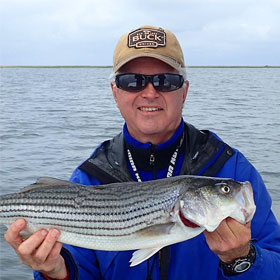Early Season Angling: How to Fish for Trout in a Lake
By Ken Schultz
May 18, 2022
Trout are most accessible when they’re shallow, which occurs in early season. Here’s what to know about how to catch trout in a lake at this time
Some of the best opportunities to catch trout in lakes exist early in the season, so here is some advice on how to fish for trout in a lake at this time. If you’re interested in knowing how to fish for trout in a pond, note that many of the same environmental factors are at work, but the size of the waterbody means that ponds warm faster and fish go deeper earlier.
How and Where Lakes Warm
After ice-out in late winter or early spring, lakes begin to warm on the surface. Trout may be found at any level at this time and are often within the upper strata, 20 feet or less, of a lake, or in shallow water close to shore.
Areas near thermal discharges, tributaries, and rocky shorelines often provide warmer water. Warmer in this instance may be 46 degrees as opposed to 43 or 44 degrees throughout the rest of the lake. Other pockets of water warmer than the rest of the lake may be found, and they can hold catchable fish.
Focus on Tributaries
In most big and small lakes and in many impoundments, tributary outlets (lake inlets) play a critical role in trout behavior and fishing success in the spring. Predator and prey species come into near-shore areas influenced by tributaries because of the presence of food and more comfortable conditions.
In the spring, rivers, streams, and the outlets of upstream dams bear runoff that helps “open up” the lake. A warm rain is a blessing for a big body of water that has a major tributary. It sometimes takes two or three days for a heavy, warm rain to have an impact throughout a big lake system. The area closest to the inlet tributary, however, will often warm up first and be especially worth fishing if it’s not too muddy. The best circumstance is an inlet with clear water that is a few degrees warmer than elsewhere.
When thinking about early spring and how to fish for trout in a lake don't overlook the importance of angling in and near tributaries and their environs, and be alert to the influence of a warm rain on trout activity.
Note also that while main tributaries, or large flows, have the biggest influence on a lake, small creeks and other sources of potentially warm water are also good places. They may not warm up a large area, but they can still attract small forage and thus trout cruising for food.
Troll to Cover Ground
When trout are shallow early in the season, they can be caught by trolling, drifting with bait, and casting from shore. Trolling allows you to cover a lot of ground and look for active, aggressive fish, particularly trout that have not been spooked or otherwise bothered by other anglers and boaters. On large lakes, you can spread your trolled offerings out and and get away from others, especially on weekends when more anglers are fishing.
Drift with Live Bait
Drift fishing is usually a live-bait proposition. Many anglers are quite successful with this technique using the prevalent local forage for bait, but it is slow and arguably less productive than trolling a lure from a boat under motor power. In lakes where motor use is prohibited, drifting may be advantageous when there is a moderate wind, and if you can fish multiple baits at different depths and distances from the boat. Covering water is always an issue so the more you spread things out the better.
How to Fish for Trout from the Shore
Shore-based anglers may be limited to one spot, such as a pier or breakwall, and must cast repeatedly in hope of attracting a moving, incoming fish. This can pay off near inlet areas, where warm river water attracts a significant number of fish. It is also possible to “troll” in a sense by walking up and down a breakwall, using a castable sideplaner to get your offering out and away.
In small lakes, however, it pays to be mobile, concentrating shore-casting efforts near prominent points, inlets, steep banks, rock- and boulder-studded shores, shorelines with sharp dropoffs to deep water, and warm bay and cove areas. These are the same places you’d work by trolling, the difference being that you can cover far more water more thoroughly in a boat.









